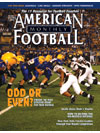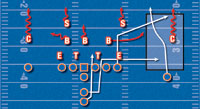AMERICAN FOOTBALL MONTHLY THE #1 RESOURCE FOR FOOTBALL COACHES
Article CategoriesAFM Magazine
|
How Boise State Runs Their Flood Routeby: Michael Parker© More from this issue Boise State was the darling of underdog teams everywhere last season when they beat traditional power Oklahoma in the Fiesta Bowl. Down the stretch, the Broncos used a couple of gimmick plays to take advantage of the Sooners’ aggressiveness. While the plays worked in that game, Boise doesn’t have a gimmick offense. Head coach Chris Petersen has led this offense for years, first as offensive coordinator under Dan Hawkins. Upon being elevated to head coach, he turned a lot of the responsibility over to current Bronco OC Bryan Harsin. Last year the offense was as good as it has ever been and capped off the undefeated season with their exciting win in Tempe against the Sooners. But they protect their home blue ‘smurf’ turf the same way that every good team does … with good coaching, good players and a good scheme. Boise State Assistant Head Coach (and Idaho native) Brent Pease came home to coach the Bronco WRs last season after having served as the Offensive Coordinator in both the SEC and Big 12. “This is a special place. It is unlike anywhere I have ever been. There is an accountability here and that isn’t true everywhere. Players and coaches both know what is expected and they go out and do it. I know that is always harped on by coaches and they always expect it from the players, but it really happens here,” says Pease. “I think that has as much to do with the success around here as anything else.” THE BRONCO OFFENSE: Based on Sound Principles, Not Trick Plays One of the plays Boise runs well – and runs often – is their basic flood pattern. “Flood is probably our number one pass route that we like to run, regardless of who we play,” says Pease. There are a few basic principles that Boise follows in their passing game that hold true in their flood package. 1. They will run it from as many formations as they can. 2. They will run it with virtually any personnel package. 3. They will run it with motions/shifts. 4. They will run it in both the drop back game and in play action. First, they can and will run their flood pattern out of pretty much any formational look imaginable. “We use every formation possible. From four wides to a 3x1 set to just a 21 personnel set where we can run it with either two receivers in a slot set. We will even run it with one receiver and a TE or we will run it off our heavier personnel set which is 22 personnel. So we can do it with just 1 WR, or 2 WRs, or even 3 or 4 WRs,” says Pease. The flood pattern can be run with one, two or three receivers to a side. There are three basic pass patterns that can be interchanged, forming a triangle and forcing the defense to worry about covering vertically as well as horizontally. Second, Boise will mix and match their personnel to isolate certain defensive personnel or scheme weaknesses. “Sometimes we like our matchups against certain teams or defenses when they get into certain looks. So we will try and match up our players against the guys on defense that we think are weaker cover guys. And depending on what defense that is, we will work with certain players and formations on the field,” says Pease. Third, the Broncos can disguise their looks with a myriad of motions and shifts. In this way, the defense can’t key on what is happening before the snap. This causes confusion with coverage responsibilities; it keys on who is going to go where. “We can always change our look with our shifting and motions packages. We can do it for variety, or window dressing or disguise what it looks like from week to week. We might run the play a bunch of different ways in the game. But with different personnel packages, certain personnel groups match up with the defensive personnel. And usually the outside receivers are the same guy. Slot guys are the same guy. And so on,” says Pease. Fourth, Boise uses the flood route in their regular drop back game as well as their play action game. This way they can get the ball out quicker (drop back) or make a fake to keep the LBs and DBs honest (play action) and possibly get the ball downfield on a deeper route. “The good thing about our system is that we can attach all the play actions of our run game. And we can add any of our protections to it. This play will match up well with most of the protections in our system,” says Pease. The Boise State Flood Route The Flood Route concept is nothing new. Boise runs it well because they coach it well and the players understand and can execute it well. Because of the success that Boise State has had passing the ball in the past, their opponents prepare for the downfield passing game even though in the past few seasons Boise has had an All-American running back in Ian Johnson. It is important to be able to throw the ball downfield. Boise has found a way to implement this flood route to help throw the ball downfield and force the defense to not just key on Johnson the entire game. For Boise, the flood route meets three of the major needs all offenses face: 1. Does it work against the major fronts/coverages WE will face? 2. Can we use it with the multiple pass protection packages we do well? 3. Does it fit with the formation and personnel packages we already use? The three main coverages the Broncos face are Cover 1, Cover 3 and Quarters Coverage. It is important to determine the main coverages that an opponent will try to use against you. Boise has found that this pass works well against almost all coverages, not just the ones they face regularly. “This can be a Cover 2 or Cover 3 beater. But, we are seeing more and more of the Quarters Coverage and it works well with that. We can use it to beat anything. We just adjust it a little bit or change the stem on one of our receivers a little bit,” says Pease. Man-to-Man Coverage Often when the Broncos line up in their heavier sets, they see Man-to-Man coverage such as Cover 1 (See Diagram 1).
“In a 3x1 set, or with 4 WRs, we’re going to have the outside guy run a take route. If the coverage is either Cover 1/3 or Quarters, where the CB is going to be the deep defender to that side, the take route is going to get our guy right on the toes of the CB. This gets us within handshake distance and then we go skinny across the field to the post. In a coverage where the safety will be the deep defender to that side (Cover 2), we are going to take the easiest release and work on the outside shoulder of the safety. “In the heavier set, the WR is still running his vertical take route. Then the TE has the corner route and the fullback has the flat. The #1 receiver (the sideline in) still runs the vertical take route. This time he might keep outside depending on where the CB lines up and what the safeties responsibilities are. If the Safety is staying inside, the WR will stay vertical. If the Safety is manned up on the #2 receiver, the outside receiver can turn the route into a skinny post and occupy both his man and the Safety. “The #2 receiver will run his corner route, making sure that he is deep enough to guarantee that the receiver moving to the flat will not be able to be covered by the same man that is responsible for covering #2. The #2 receiver is going to run a corner route at a depth of between 9-11 yards and break it high to the corner route. This way, we are working a high-low with that flat defender,” says Pease. “The #3 receiver is moving to the flat, working to get width before depth. This completes the triangle and makes a high-low read for the QB. The #3 receiver is often a RB or TE; he runs to the flats to form a triangle. We do a lot of motion to bring a third receiver across the formation to be this third receiver. And we will use play action or drop back to vary it even more. And then we can use the same concept with our heavier personnel (2 RB and 2 TE),” says Pease. Quarters Coverage In a basic 2 back, 1 tight end set, Boise has been seeing a lot more of Quarters Coverage. The responsibilities are the same for the receivers, except number #1 is really working hard to get across the deep outside defender’s face, occupying the deep inside defender to his side. This way, he is basically occupying two defenders (See Diagram 2).
Cover 3 If Boise brings in an extra WR to play in the slot, defenses typically play a form of Cover 3. It is crucial that the outside receiver works toward the post just enough to make sure that the CB can’t cover both the take route and the corner route. “Even if it is Quarters Coverage, he is still going to take it high to occupy that CB. He will still have a high-low on that flat defender,” says Pease. It should be the same triangle high-low read with the flat defender caught between two receivers (See Diagram 3).
So that is how Boise runs the flood route. A playbook staple. The difference is that they teach it well and execute it even better. And it works. |
|
| HOME |
MAGAZINE |
SUBSCRIBE | ONLINE COLUMNISTS | COACHING VIDEOS |
Copyright 2024, AmericanFootballMonthly.com
All Rights Reserved







